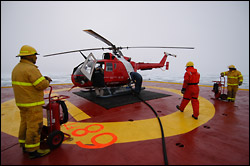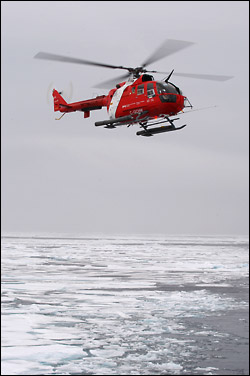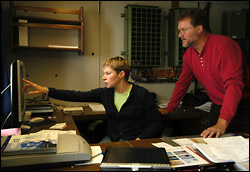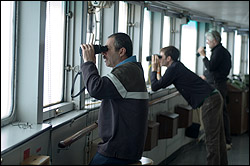Please note: You are viewing
the unstyled version of this website. Either your browser does not support CSS
(cascading style sheets) or it has been disabled. Skip
navigation.
Chris LinderAugust 8, 2005
Thanks to the expertise of the ship's ice officer, Lucie Theriault, we had a general idea of where to begin the search. Using a week's worth of highly detailed satellite maps, Lucie had been watching the movement of the ice and creating a track of where she thought the buoys were headed. By sheer luck, the area was right on our way, so the search didn't entail a time-consuming detour. If it had, chances are we wouldn't have bothered searching at all. That's because the buoys are meant to be expendable. After they are frozen into the ice, they transmit data back home via satellite phone until they fail. This can happen because of an electronics failure, the breakup of the host floe, or--believe it or not--polar bear vandalism. The main reason we wanted to retrieve these particular buoys is to find out what components failed, so that we can fix the problem in future buoys. After breakfast, it was time to fly. Rick Krishfield and John Kemp put on their parkas and got settled into the ship's helicopter. Pilot Christopher Swannell fired up the engines and blasted up off the deck, banked to the port side, and with a whoosh of rotor blades--shot off into the fog. Using a tablet laptop and handheld GPS, Lucie Theriault guided the team on a mowing-the-lawn pattern. Four pairs of eyes scanned the ice for an hour and half as they zipped back and forth barely 50 feet above the floes. When they returned, I could tell from Rick and John's expressions that they hadn't seen the buoys. The fog was making it extremely difficult to spot the 3-foot tall yellow ice-tethered profiler buoy from the air (read last year's dispatch to see how the buoys were deployed). It was like looking through that haystack blindfolded. The ice recon team was ready for another shot in the afternoon. They mapped out another area and zipped off into the drizzle. Two hours later, a disappointed crew stepped off the helicopter--still no luck, strike two. Captain Potts then suggested that we use the remaining daylight hours to try a search from the ship. He devised an expanding box search pattern in a new area that we hadn't searched yet. The hunt was on. At one point half the science party and a like number of crew members had binoculars in hand, trying to spot the buoys amid the ice. Our last valiant attempt was also unsuccessful. Strangely, we didn't even come across the thick multi-year ice that the buoys had been frozen into last year (according to John Kemp, a floe over 12 feet thick). So what happened to the buoys? Rick thinks it extremely likely that the floe broke up and the instruments sank to the bottom. While we're a bit disappointed we didn't succeed, tomorrow we'll be moving on to a subsurface mooring--one that has been anchored to the bottom collecting data for over a year... And thankfully, we know exactly where it is. Last updated: October 7, 2019 | ||||||||||||||||||||||
Copyright ©2007 Woods Hole Oceanographic Institution, All Rights Reserved, Privacy Policy. | ||||||||||||||||||||||






